Nux Vomica, Ma Qian Zi 马钱子Ma Qian Zi (TCM)Ko Byi La ཀོ་བྱི་ལ (Tibetan) Kapilu, Kakatinduka, Vishtinduk (Ayurveda) Azaraqi, Kuchla, Al-Muqsa (Unani) Azaraqi, Aishul-Ghurab (Arabic) |

|

|
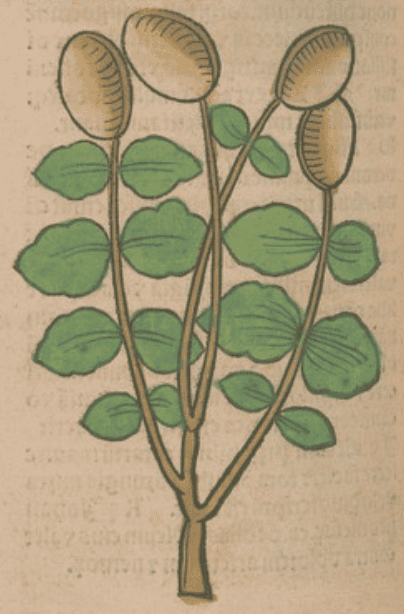 Ortus Sanitatis, Meydenbach, 1491
Ortus Sanitatis, Meydenbach, 1491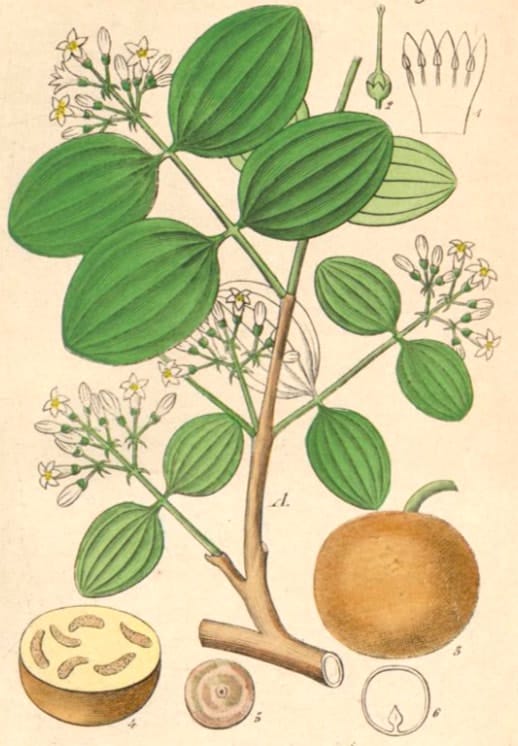 Hand-Atlas Medicinisch-Pharmaceutischer, 1884
Hand-Atlas Medicinisch-Pharmaceutischer, 1884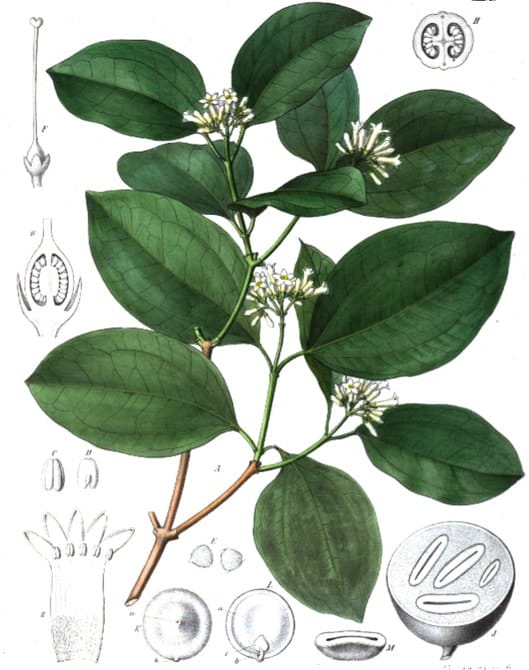 Darstellung und Beschreibung Pharmacopoea Borussica, Berg, 1858
Darstellung und Beschreibung Pharmacopoea Borussica, Berg, 1858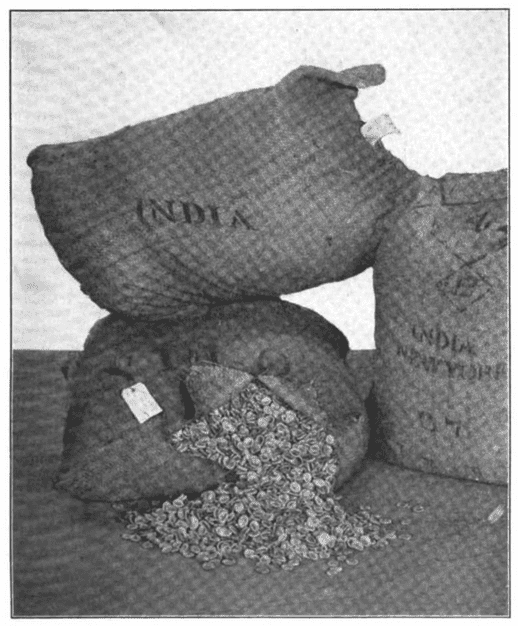 Pacakaged Nux Vomica as imported from India.
Pacakaged Nux Vomica as imported from India.A Manual of Organic Materia Medica and Pharmacognosy, Sayre, 1907
 Above: Nux Vomica seed
Above: Nux Vomica seedKrauterbuch, Lonitzer, 1578 |
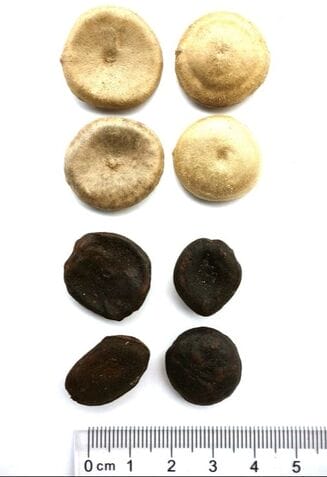
Right: Nux Vomica; Raw (top) and prepared (bottom) (Adam, 2015) |
Botanical name:
Strychnos nux-vomica
Parts used:
Purified (Detoxified) Seed; in India, occasionally the root-bark or leaf is used
Temperature & Taste:
Cold (slightly Warm when purified), Dry. Extremely Bitter, Pungent. Very Toxic
Classifications:
2F. PURIFYING. 2O. ASTRINGENT. 2Q. ANODYNE. 2R. NARCOTICS & HYPNOTICS
3I. APHRODISIAC
4j. NERVINE
TCM:
T. External Medicines
Uses:
1. Unblocks the Channels, Opens Obstruction, Regulates Qi: (West, TCM, Ayurveda, Tibet, Unani)
-a potent CNS stimulant; used for various Wind disorders
-Locomotor Ataxia, Paralysis, Facial Paralysis, Bells Palsy; used for ‘all chronic Paralytic affections’ (Squires).
-relaxed Muscles and Tendons; Trembling, and Stiffness of the Limbs
-Neuralgia including Sciatica and Trigeminal Neuralgia.
-general Debility; Neurasthenia
-Mental Disorders, Schizophrenia, Insanity; Melancholy
-Epilepsy
-Impotence, Sexual disorders
-Insomnia due to Fatigue
-Emotional disorders, Hysteria
-in Eastern medicine, in its detoxified form it is often used in large formulas to promote greater effect of the formula, clear Obstruction, regulate Qi and harmonise the Nerves. An important ingredient of Tibetan Jewel Pills.
2. Promotes Circulation, Regulates Qi, Stops Spasms, Relieves Pain: (TCM, Ayurveda, Tibet)
-pain and spasms from wind and dampness including Arthritis, chronic Rheumatism (internally & externally).
-various types of pain and neuralgia, depending on the herbs it is combined with.
3. Moves the Blood, Resolves Swellings, reduces Pain: (West, TCM, Ayurveda, Tibet)
-Sprains, Strains, Fractures etc., for which it is used internally or externally (TCM);
-a circulatory tonic in cardiac failure as it improves the pulse and raises blood pressure.
-useful in the treatment of various Cancers and Tumors.
4. Promotes Sweat, Resists Poison (West, TCM, Ayurveda, Tibet):
-promotes Sweat and expels Pestilential Fevers; for Febrile, Epidemic and Infectious diseases including the Plague
-Also for Malignant Sores, Toxic Swellings, as well as acute swollen, Sore Throat, and for Gonorrhea and Venereal Diseases.
-in Tibet and India for Filariasis as well as other Parasitic Infections.
-in compounds for all types of Poison, Venom and Toxicity including Venomous Bites, including Snake, Dog and Rat Bite.
-poisoning from Alcohol, Lead, Tobacco, and Opium, and as an antidote to their addiction;
-in Unani it is regarded as the best treatment for drug dependence.
5. Rasayana: (Ayurveda, Tibet)
-traditionally considered Tonic to the body (when purified); Tonic to the 7 Bodily constituents
-especially useful for the diseases of old age; it counteracts Senility and the diseases of the aged.
-Impotence, Sexual disorders
-gives strength, stimulates digestion and circulation, restores nervous function, is used for Rheumatic and Urinary diseases, is Aphrodisiac, alleviates Depression, and is used in various eastern formulas for chronic and obstinate diseases including Diabetes.
-said to blacken white hair.
6. Opens the Lungs, Frees the Breath: (West, Ayurveda, Tibet)
-given as a respiratory stimulant in Bronchitis, Phthisis, and Emphysema
-labored asthmatic breathing. (Ayurveda)
-difficulty breathing (Tibet)
7. Stimulates Digestion:
-Indigestion, Atony of the Stomach and Bowels
-Constipation due to intestinal debility such as occurs after long use of purgative medicines, or in old age.
8. Emetic:
-traditionally used as an Emetic (hence its name) but is not used for this purpose today.
9. Externally:
-applied to chronic Pains and Neuralgia including Facial Neuralgia.
-fried in Sesame oil, it is massaged over the painful parts in Rheumatism.
-applied topically to Trauma, Bruising, Pains, Strains and Fractures.
-applied to toxic Sores, Abscesses and other Toxic Swellings including Plague sores.
-applied to skin discoloration in India.
-a paste of the seeds is applied to Rate bites in India.
Dose:
1. Only the prepared product should be used internally. The traditionally prepared product has shown to be far less toxic (see Research below). The unprepared seed is often used in external preparations. However, the unprepared product is what has been used in western practice over the past couple of centuries.
2. Always begin with lower doses, increasing gradually.
3. In Ayurveda, Nux Vomica is always given with Milk, Butter or Ghee to mitigate its harshness.
PURIFIED NUX VOMICA (purified according to one of the methods below): dosage range: 50–250mg (125mg being a common dose), up to 500mg; daily doses of: 300–600mg (up to 900mg).
UNPURIFIED NUX VOMICA (standardised to contain 1.25% strychnine): dosage range: 20–250mg; 50mg being a common starting dose in pills or powders; maximum single dose should be 100mg, maximum daily dose, 250mg.
Some traditional healers in India and Tibet regard 1 gram (1000mg) as a safe dose for the properly purified product.
Salmon and Pomet (1748) both state that they were occasionally given internally (unprepared) in doses of 3–4 grains (approx. 200–250mg), but that full doses could cause adverse effects.
It is also used topically in powders, pastes, tinctures and plasters.
Preparation:
There are a number of ways used to process Nux Vomica in Ayurveda, Unani, Tibetan and Chinese Medicine. In all cases the seed coat is removed prior to preparing with heat. Since the seed is exceedingly hard and the seed coat is hard to remove, usually the seeds are soaked for several days to soften the skin of the seed to facilitate peeling and cutting. Then heat is used, either by being fried in Oil or heated in Sand:
1. Soak Nux Vomica for several days in water to soften the skin. Peel, dry, and cut into pieces. Stir-fry in Sesame oil until yellowish-brown, then remove and put on absorbent paper to remove excess oil. Once dried, powder and keep for use. (Ayurveda; this same method has been given by Chinese sources including Chen & Chen)
2. Put the Nux Vomica into a wok full of sand; heat and stir-fry until they swell and become dark brown-blackish, then remove and powder. (TCM)
3. Remove the outer coat, cut the seeds into 4 pieces and boil in the decoction of Amaranth roots; after drying, the seeds are triturated with Ghee. (Ayurveda)
4. Remove the outer seed coat. Then boil the peeled seeds in Cow (or Donkey) Milk in a pot two-thirds full until most of the milk has boiled away, taking care not to let it burn. The milk is discarded and the seeds are washed thoroughly in water (some recommend boiling in water after washing to thoroughly remove the milk). The seed are removed and while wet they are cut into pieces or crushed and dried. (Tibet)
There are many variations on these themes, all using heat. In TCM sometimes Black Beans, Licorice or fresh Ginger juice is used in the preparation. Ayurveda soaks the seed in Cow urine, and Tibetan Medicine soaks in Cow Milk instead of water. One method in Unani puts the seeds in clay which is kept moist for 10 days before peeling, cutting and frying. The seeds are extremely hard and the peel is difficult to remove. Therefore, prolonged soaking is used to facilitate peeling and to soften the seeds for cutting.
Correctives:
1. Licorice; taken in equal weight of the Nux Vomica is said to counteract poisoning
2. Cinnamon
Main Combinations:
Nervous Disorders, Paralysis:
1. Nervous stimulant in Paralysis:
i. prepared Nux Vomica with Black Pepper. (Pills of Nux Vomica, Unani)
ii. prepared Nux Vomica, Opium, Black Pepper, form 2 grain pills (as in Samiragaja Kesari of Ayurveda)
iii. prepared Nux Vomica with Licorice
iv. Bells Palsy and Hemiplegia, prepared Nux Vomica with Cinnamon, Nutmeg, Peony and Clove (as in Pills of Nux Vomica [2], of Unani)
v. Facial Paralysis and Paralysis, prepared Nux Vomica with Aloeswood, Cardamon, Emblic Myrobalan, Sandalwood, Valerian, Long Pepper, Clove, Mastic, Saffron (as in Electuary of Nux Vomica, Unani)
2. Paralysis, Epilepsy: Extract of Nux Vomica (2–4, or 6 grains), dissolve in Lemon Balm Water (6 oz.). Dose: 2 tablespoonfuls twice daily. (Sobernheim, 1840)
3. Neurasthenia, Hemiplegia, Facial paralysis, Tremor, Trembling, Arthralgia and Epilepsy: prepared Nux Vomica with Long and Black Pepper, Cinnamon, Nutmeg, Mastic, Cyperus rotundus, Clove, Emblic Myrobalan, Indian Spikenard, Saffron, Aloeswood (as in Majoon-e-Lana of Unani Medicine)
4. Trigeminal Neuralgia, prepared Nux Vomica with Black Pepper, Shilajit, and Iron Bhasma (Unani)
5. Mental and physical exhaustion, prepared Nux Vomica with Valerian
6. Wind disorders of the upper body including Tinnitus, Vertigo and shortness of Breath, prepared Nux Vomica with Inula racemosa, Tinospora, Chebulic Myrobalan, Aloeswood, Lesser Cardamon, Nutmeg, Costus, Bdellium, Madder (as in Nux Vomica 13 of Tibetan Medicine)
Poison, Infection:
7. Against Plague, contagion and infection:
i. take prepared Nux Vomica with Confection of Hyacinth. (Salmon)
ii. take prepared Nux Vomica with Theriac and/or Mithridate.
8. Obstinate Skin diseases, Viper (Bai Hua She), Scammony, prepared Nux Vomica, Pyrethrum, Saffron, Scorpion, Aloe, Frankincense (as in Qubaimaribairesi Pills of Uyghur Medicine)
9. Toxic Abscesses and Cancerous Sores:
i. prepared Nux Vomica, Black Sesame seed, Frankincense, Bamboo leaf (equal parts). Powder together, then form pills. (Chinese Materia Medica, Stuauoft)
ii. and for Wounds, prepared Nux Vomica, Black Sesame seed, Dragon’s Blood, Sulphur, Centipede, formed into pills with Honey. (Chinese Materia Medica, Stuauoft)
10. Gonorrhea, Decoction of Cucumber, Linseed oil, Egg Yolk, Honey with extract of Nux Vomica. (Pharmacopoeia extemporanea, Augustin, 1822)
Stomach & Digestion
11. For indigestion and stomach debility:
i. prepared Nux Vomica with Gentian.
ii. prepared Nux Vomica with Wormwood
iii. with Stomach pain, prepared Nux Vomica with Chebulic Myrobalan, Long Pepper, Black Pepper, Ginger, Asafetida, Sulphur, Rock Salt (equal parts, make 4 grain pills) (Sulharanayoga)
Arthritic Diseases
12. Arthritis, Rheumatism:
i. prepared Nux Vomica with Earthworm. This is also used for Muscular Atrophy (as in Ma Qian Zi San of the Chinese Pharmacopoeia)
ii. prepared Nux Vomica (30 grams), Dragon’s Blood (Xue Jie) (60 grams). Powder and take in doses of 1500mg twice daily. This was tried in a group with chronic disease that had not responded to other therapy with great effect within a couple of doses for most patients.
iii. prepared Nux Vomica with Frankincense (Ru Xiang), Myrrh (Mo Yao), Ephedra Ma Huang, Scorpion (Quan Xie) and Licorice (TCM)
iv. prepared Nux Vomica with Aconitum Fu Zi, or Aconitum Cao Wu or Aconitum Chuan Wu. This powerful combination potently opens obstructions, clear Wind-Cold-Damp, and relieves pain.
v. prepared Nux Vomica with Aconitum Fu Zi, Aconitum Chuan Wu, Ginseng, Deer horn, Safflower, Myrrh, Mistletoe, Asarum and Licorice (TCM)
vi. Wind-Cold-Damp Joint pain, Homalomena Qian Nian Jian, Myrrh (Mo Yao), Frankincense (Ru Xiang), Pyrite (Zi Ran Tong), Cinnamon twig (Gui Zhi), Achyranthes Niu Xi, Eucommia Du Zhong, Saposhnikovia Fang Feng, Notopterygium Qiang Huo, Angelica Pubescens Du Huo, Licorice (of each 9 grams), prepared Nux Vomica prepared (Ma Qian Zi) (90 grams), Ephedra Ma Huang (120 grams). Form honey boluses of 6 grams each; Dose: one bolus twice daily with warm water (as in Shu Feng Ding Tong Wan).
vii. Bath for Arthritis: Nux Vomica, Ephedra Ma Huang, Saposhnikovia Fang Feng, Safflower (Hong Hua), Myrrh, Frankincense, Notopterygium Qiang Huo, Vaccaria Wang Bu Liu Xing, Pueraria Ge Gen, Chaenomeles Mu Gua (30 grams each). Prepare as a bath or wash which can be used for a number of days. (The Formulas of Dr. John H.F. Shen)
Cancer
13. Cancer:
i. prepared Nux Vomica with Realgar (TCM)
ii. prepared Nux Vomica with prepared Arum root and Cinnabar (Tibetan Folk Remedy)
iii. prepared Nux Vomica (Ma Qian Zi) with Toxicodendron Gan Qi, Chinese Agrimony, Curcuma Yu Jin, Alum, Niter, Trogopterus Wu Ling Zhi (Flying Squirrel Feces) and immature Orange Zhi Shi (as in Ping Xiao Capsules, TCM).
Other
14. Cardiac tonic:
i. Nux Vomica tincture has been combined with Foxglove and Compound Gentian Tincture.
ii. Cardiac debility, Nux Vomica has been combined with Belladonna.
15. Diabetes, Nux Vomica, Plumbago zeylanica, Tribulus seed
16. As an Emetic:
i. prepared Nux Vomica with an equal weight of Fennel or Dill seed (Abram, out of Serapion)
ii. Cardamon, Radish seed, Nux Vomica, equal parts, taken with Honey water or decoction of Dill. (Serapion)
iii. prepared Nux Vomica with Fennel seed, Mustard seed, Natron (Ebn Baithar)
17. Topically for pain, swelling and bruising, combine Nux Vomica with Frankincense and Myrrh and form a paste with vinegar for topical application.
18. Nux Vomica is boiled in oil with Garlic, it has been applied to rheumatic diseases (Ayurveda)
Major Formulas
Electuary of Nux Vomica (Majun Azaraqi) (Unani)
Electuary of Eggs (Maximilian)
Jiu Fen San (TCM)
Feng Shi Ma Qian Pian
Ping Xiao Capsules
Nux Vomica 13 (Ko byi bcu gsum) (Tibetan)
Nux Vomica 15 (Ko byi bcu lnga) (Tibetan)
Aloeswood 20 (A gar nyi shu) (Tibetan)
Aloeswood 35 (Tibetan)
Bright Red Decoction (Dmar chen thang) (Tibetan)
Calm the Shocked Mind 20 Pills (Mogolian)
Crystal Moon 37 (Zla shel so bdun) (Tibetan)
Great Precious Purified Moon Crystal Pill (Rin chen tso bkru zla shel) (Tibetan)
Life Holding Jewel (Srog ‘dzin nor bu) (Tibetan)
Precious and Great Multi-Jewel Compound Pill (Rin chen mang sbyor chen mo) (Tibetan)
Undying Aloeswood 8 (Chi med a gar brgyad pa) (Tibetan)
Cautions:
1. Highly toxic when used raw; still toxic after preparation, although much less so. 1 ½–3 grams of the unprocessed seed is toxic, as little as 4 grams can be fatal.
2. Not used in Pregnancy or in young Children.
3. Not used in acute Paralysis with inflammation.
4. Do not apply over a large part of the body when used externally. Toxic constituents are readily absorbed and can result in toxicity.
Toxicity:
1. Highly toxic in raw state, the properly prepared product is still toxic, but far less so. Research has shown the traditionally purified or prepared product to be far safer and lower in toxic alkaloids.
2. Overdose causes dry mouth, dizziness, headache, numbness, palpitations, tonic-clonic convulsions, increased sensitivity to light and sound, respiratory depression.
3. Orally in humans, strychnine causes toxic effects in doses of 5 to 10 mg (approxinately 400–800mg of unprocessed Nux Vomica seed), while fatalities have been reported with 30mg of strychnine (equivalent to approximately 2500 mg of unprocessed Nux Vomica seed).
4. “Tabernamontanus, Lib. 3. Cap. 14. affirmes 2 drams weight of it, is poison, and will kill any one; but, a Drachm will only intoxicate a mans braines so as that he will seeme to be inebriated; with whom also, Sennertus agrees” (De venenis, Ramesey, 1663). This seems an excessive dose. It may be because Nux Vomica once it arrived in Europe was already aged enough to become less virulent.
5. LD50 for strychnine by oral route in mice is 3 mg/kg
Antidotes:
1. In early stages, Charcoal given immediately, followed by vomiting
2. Strong Decoction of Cinnamon (TCM)
3. Ghee is viewed as an Antidote in Ayurveda. Purified Nux Vomica can be taken with Ghee to prevent side effects. Milk is also used but is less effective.
4. Licorice taken in equal weight of the Nux Vomica is said to counteract poisoning. This has been confirmed by modern research)
5. Zedoary powder (2 drams) with wine.
6. Lemon juice has been used in Ayurveda. Citron juice was used in the West.
7. Citron juice, Myrtle juice, taken with wine. (De venenis, Petrus, 1487)
8. Citron peel with its juice.
9. Lemon rind. (De venenis, Petrus, 1487)
10. Herb Paris (True Love) has been used (West)
11. Decoction of green Mung Beans (120 grams) and Licorice (30 grams). (modern Chinese antidote)
12. Decoction of Cinnamon (6 grams), Licorice (60 grams), Galls (Wu Bei Zi) (12 grams) .
13. Severe convulsions following Nux Vomica, Centipede (Wu Gong) and Scorpion (Quan Xie) (equal parts), powdered and taken in doses of 1–2 grams. (TCM)
14. Severe poisoning: decoction of Ariseame Tian Nan Xing (12 grams), Saposhnikovia Fang Feng (12 grams), Gastrodia Tian Ma (12 grams), Centipede (Wu Gong) (3 pieces), Scorpion (Quan Xie) (6 grams), White Dead Silkworm (Bai Jiang Can) (15 grams), Licorice (10 grams). (Chen & Chen)
Main Preparations used:
Detoxified Seed, Powder of Nux Vomica, Pills of Nux Vomica, Tincture of Nux Vomica, Extract of Nux Vomica
1. Powder of Nux Vomica:
i. Nux Vomica (3 grains), Gum Arabic, White Sugar (½ scruple each). This can be taken as a dose. (Pharmacopoeia extemporanea, Augustin, 1822)
2. Pills of Nux Vomica (Stimulant Pills):
Paralysis, Epilepsy, Chorea, Hysteria, Hypochondria etc.
i. Nux Vomica (½ dram), Conserve of Rose (sufficient). Make 10 pills. Dose: 1 pill, 2 or 3 times daily. (Ellis)
ii. Nux Vomica (1–6 grains), White Sugar (½ scruple), Rob of Elder (sufficient). Make 6 pills. Dose, one every 2 hours.
3. Tincture of Nux Vomica:
i. Nux Vomica rasped (1 part), Diluted Alcohol (8 parts). infuse without heat for 3 days; digest in a water-bath for 6 hours, express and filter. (Pharmacopee Usuelle, Louvain, 1821)
4. Water Extract of Nux Vomica:’
i. Nux Vomica rasped (1 lb.), Boiling Water (8 lbs.). Digest 24 hours; boil for 15 minutes, strain; boil the residue in Water (4 lbs.) for another 15 minutes, strain again. Mix the two liquors, set aside, decant and evaporate. (Pharmacopoeia Manualis, Antwerp, 1812)
Dose: 2–20 grains (increase slowly)
5. Alcoholic Extract of Nux Vomica:
i. Nux Vomica rasped (8 oz.), Proof Spirit (2 pints). Digest 3 days in a close vessel; strain with strong expression, add to the residue Proof Spirit (1 ½ pints); digest for 3 days and express again. Mix the tinctures, distil till reduced to one-quarter and evaporate the residue, constantly stirring to the proper consistency using the medium heat of steam. The softer extract should be sprinkled with rectified Spirit.
ii. Nux Vomica rasped; digest in alcohol, strain and filter and add more alcohol, repeating the process until there is no color or taste. Mix and filter the tinctures. Draw off the alcohol with distillation, then evaporate in a water-bath to an extract.
Dose: 1–2 grains in Paralysis, increasing by one grain every day until the desired effect is achieved. In this way, the dose has been increased to 24 or 30 grains per day before tetanic symptoms show.
|
‘No mention of Nux-vomica can be found in the older Sanskrit medical works. A drug called Vishamushti, mentioned by Sarangadhara, has by some been supposed to be nux-vomica, but according to the Bhavapra-kasha, Vishamushti has an edible fruit, and is called Karerua in Hindi. The latter work gives Kupilu and Kulaka as Sanskrit names for Kuchila, but these names are generally referred to a kind of ebony. Another Sanskrit name given to the drug in recently compiled works is Kurachilla, an incorrect form of Kuruchilla, ” a crab,” to which animal the seeds bear some resemblance in shape. We think there can be little doubt that nux-vomica was not used medicinally by the ancient Hindus, but the Hindi name Kuchila or Kuchula occurs in ancient Persian, and appears to be derived from the Sanskrit (kunch) to make crooked. We also find an unidentified plant called Kuchela, mentioned by Sanskrit writers, with the synonyms of Avi-karni and Viddha-parni; the name Kuncha-phalais also met with, but it may possibly be only an incorrect rendering of Kuchaphala, a term for the pomegranate. We can hardly suppose that a plant having such marked poisonous proper ties can have escaped the notice of the earliest settlers in India, and there can be no doubt that the wood has been in use from a very early date as one of the kinds of Mushadi in Southern and Western India. We also find that in the Indian Archipelago, which was colonised at a very early date by the Hindus, the wood is used as a popular remedy for dysentery, fevers and dyspepsia, under the name of Bidara-laut by the Malays. This name appears to be of Sanskrit origin and to be derived from Vidara, “splitting or rending,” and lata, “a tree or shrub,” in allusion to the tetanic spasms produced by over-doses of the drug. In the Raja Nirgbanta two kinds of Katuka are noticed; one of these with the vernacular synonym Kedar-kattiki is doubtless Picrorrhiza Kurroa, the other Katukavalli with the Canarese synonym Tonremattu, which does not appear in the vernacular Nighantas, must, we think, be referred to the bitter woods used as lignum colubrinum. It has been supposed by some that nux-vomica was the Jouz-el-mathil of the early Arabian writers, but this drug is described by Ibn Sina as studded with thick thorns, and as producing torpor when eaten; it is considered by all the more, recent Mahometan writers to be Datura. The Jouz-el-kai of the Arabs has also been supposed to be nux-vomica, but there would seem to be no foundation for such a belief, as it is described as having properties similar to Joua-el-mathil, and is probably the fruit of a Trichilia. All the Indian Mahometan physicians describe nux-vomica under the name of Azaraki; of this drug Ibn Sina merely says it is a kind of Zabad-el-bahr. (foam of the sea), a name given by the Arabs to the cuttle fish bone; he adds that it is not used internally, but applied externally in skin diseases and sciatica. Haji Zein-el-Attar (A.D. 1368) is the first who clearly identifies Azaraki with the Indian drug Kuchula; he gives the same description of its uses as Ibn Sina, and says the antidotes for it are fresh milk and oil (these are the popular antidotes for it at the present day in India, but in Madras dog excrement is also used). In the Makkzan-el-adwiya azurdki is said to be a Syrian word, but. it appears to us more probable that it has been manufactured by the Syrian physicians, who instructed the Arabs in Greek medicine, from the words aza and paxia, and that it intended to be a Greek rendering of the Arabic Zabad-el- bahr. The author of the Makhzan gives Kuchila as the Indian name for nux-vomica, but says it is best known in Hindustan (Northern India) as Nirbhedin (a Sanskrit word which signifies splitting asunder, derived from ?). Nux-vomica is not mentioned by Garcia d’Orta who was in Goa, where the tree is very common, about the middle of the 16th century— a tolerably clear proof that it was not used medicinally at that time— but his contemporary Valerius Cordus in Europe describes it accurately. The seeds do not appear to have been used medicinally until about the middle of the 17th century, but Rheede mentions the root as an established remedy in Malabar, and we have much |
earlier records of its use on the Western Coast as a substitute for the true Lignum Colubrinum, a drug held in high estimation as a tonic, antiperiodic and alexi-pharmic in Southern India under the name of Nagamushidi. On the whole we are of opinion that the Arabs were acquainted with nux-vomica seeds under the name of azaraki, but that they imagined them to be of marine origin,— a comparatively modern Arabico-Persian name for them is Fulus-mahi (“fish scales”); this is the more likely, as the tree is especially a native of the Western and Southern Coast districts of India, and the seeds like those of several other plants are liable to be carried to a distance by oceanic currents: Ainslie speaks of nux-vomica as a drug which is little used; he rightly states that the pulp of the fruit is poisonous, and the authors of the Pharmacographia have since shown that it contains strychnine; nevertheless it is eaten by the hornbill and other birds, He also tells us that the Vytiaus are of opinion that if the seeds are not taken in sufficient quantity to cause death, they will produce mental derangement. Loureiro, states that the seeds roasted to blackness are really useful, and can be given without danger in fluor albus. In the Concan small doses of the seeds are given with aromatics in colic, and. the juice of the fresh wood (obtained by applying heat to the middle of a straight stick to both ends of which a small, pot has been tied) is given in doses of a few. drops in cholera and acute dysentery. In some districts small quantities of the seeds are taken, apparently as a stimulant, or in lieu of opium. They also enter into the composition of the balcha pills, used, in the preparation of Mahwa and other country spirit (see Bassia). In European medicine strychnine is usually preferred to the crude drug in which the proportion of alkaloid varies considerably. In 1883 Professor Bentley drew attention to this fact as affecting the strength of the extract, stating that he had suffered serious personal inconvenience from the variation in strength of extracts prepared from different kinds of seed. This statement led to the examination of five samples of commercial nux-vomica by Messrs. Dunstan and Short, who found that the proportion of alkaloid contained in them ranged from 2.56 to 3.57 per cent. Subsequent experiments conducted by Dr. Schweissinger showed that the German official preparations varied considerably in strength, he therefore proposed that the strength of the tincture should be fixed at 0.2 per cent, of alkaloid; and that of the extract at 15 per cent., which would practically agree with the standards adopted in the new British Pharmacopoeia. It must be borne in mind, however, that the tincture and extract of nux-vomica contain brucine and other constituents, and that therefore its medicinal action may differ from that of strychnine; indeed they are considered by some to be more efficient than that alkaloid in atonic dyspepsia. H. Beckurts {Arch, der Pharm., 1890, 330—347) remarks that if the physiological action of strychine and brucine is as given by Falck 1: 38.5, then little is accomplished by a total alkaloid determination; it would be more to the point to require a fixed percentage of strychnine and disregard the brucine (of which an equal quantity could always be assumed). An extract with fixed strychnine percentage and a brucine percentage varying within 1*8 per cent, is undoubtedly more reliable than an extract containing a fixed quantity of total alkaloid in which the strychnine present might vary 1*8 per cent. Beckurts obtained the following alkaloidal percentages from nine samples of nux-vomica:— Bombay, 2 samples, 2.33 and 2.30 per cent.; Malabar, 1 sample, 2.66 per cent.; Cochin, 3 samples, 2.51, 2.41 and 2.81 per cent; Madras, 2 samples, 3.42 and 1.53 per cent.; Calcutta, 1 sample, 2.40 per cent. In a total of ten determinations made, assuming strychnine and brucine to be present in equal proportion, the yield of strychnine varied between 2.17 and 2.88 per cent. (Pharmacographia Indica, Dymock, 1891) |
